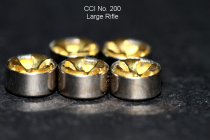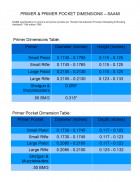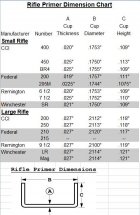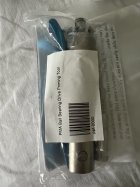funny, I've never read about the Redding "slide" primer installer. Fastest thing I've found.
You are using an out of date browser. It may not display this or other websites correctly.
You should upgrade or use an alternative browser.
You should upgrade or use an alternative browser.
Primer seating depth
- Thread starter swadiver
- Start date
Dusty Stevens
Shiner
Someone once remarked on here that the primer was a critical component because that is where everything starts. They went on to say that because it's where it all begins very small minute differences will have a profound effect on accuracy. At the time I was chasing an accuracy issue with a particular rifle and it all sounded pretty good...like maybe something easy enough to test out.
I have always just used a Lee priming tool with the tray and seated by "feel". I did notice that I was starting to get some slightly high primers and careful inspection revealed some wear on the pot metal parts of the priming tool.
I had to call Forester for something unrelated and asked the guy if anyone made a priming tool that was positive seating. That is to say one that was adjustable and able to seat all primers to a given depth and force. He recommended the Lee Ram Prime. For $15.00 I got nothing much to loose but time, so I got one. They also sent me the repair parts for the auto prime tool. I played around with uniforming tools and both methods of seating primers and with the most accurate rifle I own {shoots around 3/8" groups at 100} I was unable to discern any difference for the shooting I do.
Early in this thread someone remarked that "primers were different thicknesses" or sizes...it is my understanding that so-called match or "benchrest" primers are stamped out of a sheet of metal that is held to tighter tolerances of thickness. In fact, I have read where this is the only difference. I've never been able to tell a difference accuracy wise {group size at 100} either way with match or other primers either.
Match primers are actually visually inspected going down the line. Some have different colored anvils so you could spot a bad one instantly in a sea of primers
Match primers are actually visually inspected going down the line. Some have different colored anvils so you could spot a bad one instantly in a sea of primers
I am not doubting this at all, but I have to wonder...how does someone look at a group of primers that are all the same and see some difference going down the line??? Or maybe another way of asking, "visually inspected" for what???
I must not be understanding, I have never seen a different color anvil in a box of primers...they were all always the same. I have seen different colors, but they were also different primers, as to be expected. Do you mean they are looking for different primers getting mixed together?? Doesn't seem like that would qualify as "match" or "benchrest" just because they are not mixed up....one would hope in a given box that they are all the same???
What I read somewhere, some reloading book, was that the sheet of metal for standard primers was within .002" overall thickness. The sheet for match primers had to be .0005" to .001" thickness tolerance overall.
I might be wrong, maybe it was something else, but I think I have seen primers with different color compound in them too.
After talking to a tech at Federal regarding match primers, he stated that match primers are ‘charged’ by the most experienced charger per shift to be more exact in priming compound amount, nothing was mentioned about the sheet thickness or tolerance of such.
According to the tech, primers are made with the anvil ‘high’ in the cup, and when seated in the case, the anvil legs, cup and priming compound are ALL compressed to the correct amount when the anvil feet and the cup are on the bottom of the cup flush with each other and NO distortion of the cup itself.
He said if so much pressure is placed on the cup that it flattens, then the priming compound will most likely be damaged and misfires could result.
Their recommendation was to seat primers .005”-.008” below flush to obtain the correct seating depth.
If I go by ‘feel’, I can feel the primer bottom out when the lever on my handtool hesitates and there is some spring in the lever telling me I am about to compress the compound if I squeeze harder.
Which I have done, and found the cup flattens some going further.
So, I seat so that the minimum, in reason, that I look for is .005” below flush, but only if it ‘feels’ right.
Cheers.

According to the tech, primers are made with the anvil ‘high’ in the cup, and when seated in the case, the anvil legs, cup and priming compound are ALL compressed to the correct amount when the anvil feet and the cup are on the bottom of the cup flush with each other and NO distortion of the cup itself.
He said if so much pressure is placed on the cup that it flattens, then the priming compound will most likely be damaged and misfires could result.
Their recommendation was to seat primers .005”-.008” below flush to obtain the correct seating depth.
If I go by ‘feel’, I can feel the primer bottom out when the lever on my handtool hesitates and there is some spring in the lever telling me I am about to compress the compound if I squeeze harder.
Which I have done, and found the cup flattens some going further.
So, I seat so that the minimum, in reason, that I look for is .005” below flush, but only if it ‘feels’ right.
Cheers.
This is the correct answer. If anyone has any doubt about this take a trip to the Super Shoot some time. There will usually some engineer type guys there from Federal that you can ask directly. They will tell you exactly what Grimstod did.Seat by feel. Not measured depth. Setting them below flush is just a given for safety.
The anviles feet must be bottomed out. If they are not then your SDs go up. Been proven over and over again in benchrest.
Dusty Stevens
Shiner
This is the correct answer. If anyone has any doubt about this take a trip to the Super Shoot some time. There will usually some engineer type guys there from Federal that you can ask directly. They will tell you exactly what Grimstod did.
And they will tell you every year the only difference in a match and regular primer is the visual inspection. Ive never heard the more experienced charger thing in the 25-30 times ive talked to them but since a machine does it i wouldnt doubt it. They used to have purple anvils instead of bare gold color. You can spot a gold anvil in an acre of purple ones. Not sure if they still have the purple or gold anvils i havent had to buy any gmm in many many years
The problem in this area is fellows not wanting to accept that seating primers by feel works very well. I think that this is because there are a lot of them who have too high of an opinion of what they reason out that do not do any meaningful testing. Not only do they want the answer, they want one that agrees with their reasoning, even though there is no experience behind it. I have said it before; all of the short range group benchrest shooters that I know seat by feel. Generally since there are world record holders and highly placed Benchrest Hall of Fame members among them I can say with some confidence that they shoot better than we do. Find something else to obsess about, and if you want to copy someone, copy the folks that are getting the best results.
My take on primer seating depth is pretty simple. The image below is a CCI 200 Large Rifle primer. Note how the anvil extends above the primer cup.

Next look at primer verse cup sizes.

Now it doesn't take much effort to measure a primer pocket depth or the height of an individual primer. I seat a primer till it bottoms out in the pocket. Since I hand prime every case it does not take much to seat by feel.
If I really am interested in doing my own test it will consist of loading much more than a few rounds as in at least 5 to 10 rounds at progressing seating depth and making sure all other variables are as close as I can get them.
Personally I seat till I feel a primer bottom out in a case and call it primes. This normally amounts to a primer seating 0.003" to 0.005" below the case head. Lot to Lot and Manufacturer to Manufacturer depending on cup height and how high above the cup rim primer seating depth will vary.
Just me but I see too many other variables to be concerned with. Seating till a primer bottoms out, by feel works for me.
Just My Take...
Ron

Next look at primer verse cup sizes.

Now it doesn't take much effort to measure a primer pocket depth or the height of an individual primer. I seat a primer till it bottoms out in the pocket. Since I hand prime every case it does not take much to seat by feel.
If I really am interested in doing my own test it will consist of loading much more than a few rounds as in at least 5 to 10 rounds at progressing seating depth and making sure all other variables are as close as I can get them.
Personally I seat till I feel a primer bottom out in a case and call it primes. This normally amounts to a primer seating 0.003" to 0.005" below the case head. Lot to Lot and Manufacturer to Manufacturer depending on cup height and how high above the cup rim primer seating depth will vary.
Just me but I see too many other variables to be concerned with. Seating till a primer bottoms out, by feel works for me.
Just My Take...
Ron
RegionRat
Gold $$ Contributor
N.B. In the table, the primer height dimension is the over-all height, not the cup height.
This over-all dimension can be larger than the primer pocket depth, but that does not mean primers will stick up above flush, it is because the over-all primer height includes the anvil prior to “crush”.
The actual primer cup dimensions are not shown, but are typically at least 0.002” below flush when the primer pocket depth is at a Maximum Material Condition (or the shallowest primer pocket depth dimension).
Lately there have been some primer seating versus performance threads, and I know this can be confusing, especially when the cup dimensions are not published by their industry. If you mistake the dimensions above for the actual cup height, for example small rifle primer 0.125 max - small rifle pocket 0.117, then a primer would stick up 0.008”. However...That is not what those dimension on the primer height mean, so just pointing it out.
This over-all dimension can be larger than the primer pocket depth, but that does not mean primers will stick up above flush, it is because the over-all primer height includes the anvil prior to “crush”.
The actual primer cup dimensions are not shown, but are typically at least 0.002” below flush when the primer pocket depth is at a Maximum Material Condition (or the shallowest primer pocket depth dimension).
Lately there have been some primer seating versus performance threads, and I know this can be confusing, especially when the cup dimensions are not published by their industry. If you mistake the dimensions above for the actual cup height, for example small rifle primer 0.125 max - small rifle pocket 0.117, then a primer would stick up 0.008”. However...That is not what those dimension on the primer height mean, so just pointing it out.
N.B. In the table, the primer height dimension is the over-all height, not the cup height.
This over-all dimension can be larger than the primer pocket depth, but that does not mean primers will stick up above flush, it is because the over-all primer height includes the anvil prior to “crush”.
The actual primer cup dimensions are not shown, but are typically at least 0.002” below flush when the primer pocket depth is at a Maximum Material Condition (or the shallowest primer pocket depth dimension).
Lately there have been some primer seating versus performance threads, and I know this can be confusing, especially when the cup dimensions are not published by their industry. If you mistake the dimensions above for the actual cup height, for example small rifle primer 0.125 max - small rifle pocket 0.117, then a primer would stick up 0.008”. However...That is not what those dimension on the primer height mean, so just pointing it out.
Yup. And just the other day I measured some of my Federal and CCI LR and SR primers and the "cup" height (not the additional height of the anvil) matched right on what's shown on this list:

DeerHunter82
Gold $$ Contributor
I use the RCBS bench primer with the Holland attachment. Works quite well and consistently.
I use the RCBS bench primer with the Holland attachment. Works quite well and consistently.
Same. Just ask about Holland’s shipping fees before placing an order.
That PMA tool looks nice. I wouldn’t mind trying one.
Dave M.
F-Open Class shooter (284 win, 6dasher, 6.5-7PRCW)
Agree. JOE R is just flat WRONG telling people that you want the primer to seat flush, not proud and not recessed. This is just flat OUT WRONG and I wish that people would not offer advice on something they clearly are uneducated on. Primers should ALWAYS be recessed 1-4 thousandths (I personally uniform all pockets and recess all primers to .002” recessed.Hmm I guess I have been doing it wrong... You don't want it recessed a bit??? I load alot of auto which you do want it down a bit.. Not trying to be sarcastic I am really asking... I just use a hand primer btw..
Dave
You just seat them till you feel them bottom.I now have a tool that offers adjustable depth primer seating. the new Frankford Arsenal tool is pretty slick for $60.
I use Sinclair's fixed depth primer pocket uniformer on all my Lapua brass (.308, 6BR, .223) so all brass is cut to the same depth. I use CCI BR2s, #450s, and BR4s.
my questions are, how far deep do I seat them? what form of testing will confirm the "correct" amount? will it show up in ES and SD data on the LabRadar? Does it really matter as long as they go bang every time?
inquiring minds want to know
Danny
Hmmm??? So, what do you do when the primer pockets are .130" and the primers measure .126"?Agree. JOE R is just flat WRONG telling people that you want the primer to seat flush, not proud and not recessed. This is just flat OUT WRONG and I wish that people would not offer advice on something they clearly are uneducated on. Primers should ALWAYS be recessed 1-4 thousandths (I personally uniform all pockets and recess all primers to .002” recessed.
Dave
Or, does it matter?
How many of you have seated a primer in your usual fashion, and then carefully removed it and examined it under magnification to see where the bottoms of the anvil feet are in relation to the edge of the cup? I have. The rest of you are apparently guessing and assuming. I am not saying that your primers do not go bang, just that there seems to be a lot of assumption and guessing going on. Do you not think that the primer manufacturers know how their primers are supposed to be seated? An earlier poster reported the same answer that I got from CCI, which was that the primer should be seated so that the bottoms of the anvil feet should be flush with the edge of the cup. In my experience that takes a lot of force when using a hand tool.
Still using a Lee Autoprime even though I have a Sinclair and a PMA. I've seen no difference other than the Lee is faster, more poorly made and the feel is not as good as the other two. Maybe this stuff matters at 1000 yards, but it is white noise at the distances I shoot so I'll continue to do what I do, YMMV
Similar threads
Upgrades & Donations
This Forum's expenses are primarily paid by member contributions. You can upgrade your Forum membership in seconds. Gold and Silver members get unlimited FREE classifieds for one year. Gold members can upload custom avatars.

Click Upgrade Membership Button ABOVE to get Gold or Silver Status.
You can also donate any amount, large or small, with the button below. Include your Forum Name in the PayPal Notes field.
To DONATE by CHECK, or make a recurring donation, CLICK HERE to learn how.

Click Upgrade Membership Button ABOVE to get Gold or Silver Status.
You can also donate any amount, large or small, with the button below. Include your Forum Name in the PayPal Notes field.
To DONATE by CHECK, or make a recurring donation, CLICK HERE to learn how.













